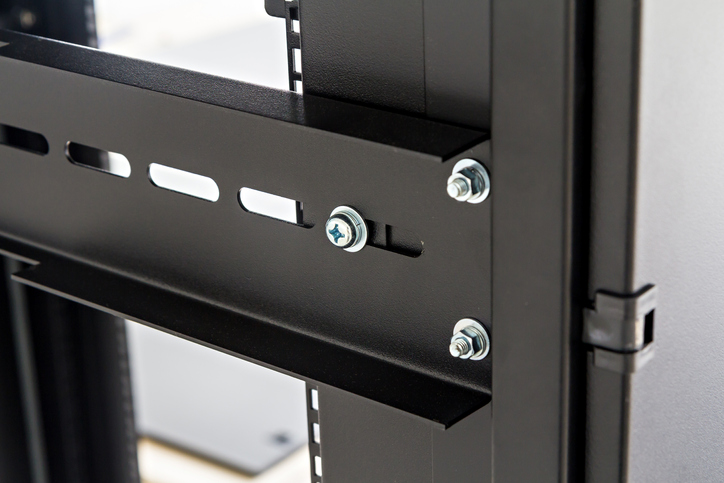Steel vs. Aluminum UPS Battery Racks: A Spec Guide
When designing Uninterruptible Power Supply (UPS) systems, engineers often focus on batteries, power distribution, and monitoring software. Yet, the UPS battery racks that house these critical systems play an equally vital role in ensuring long-term reliability and performance.
A poorly designed rack can lead to misaligned trays, restricted airflow that shortens battery life, costly service delays, and significant compliance risks. Across multiple deployments, these inefficiencies compound into higher total costs and greater operational risk.
As a roll forming partner with over 120 years of manufacturing experience, we know the right rack design does more than just hold batteries; it actively supports performance, serviceability, and regulatory compliance.
By engineering racks with precision from the start, components arrive at your site installation-ready and easier to certify. In this guide, we'll compare steel and aluminum, explore the advantages of roll forming, and show you how to specify a rack that delivers strength, safety, and long-term value.
UPS Rack Risks and How Roll Forming Solves Them
UPS racks directly affect how batteries perform and how technicians interact with equipment. The wrong material or manufacturing process introduces recurring problems that reduce reliability and drive costs higher:
- Weak load paths: Misaligned uprights and rails create uneven weight distribution, risking connection failures.
- Thermal inefficiency: Blocked airflow creates hot spots, which shorten battery life and reduce uptime.
- Service inefficiency: Sharp edges, misaligned holes, and extra rework add hours of labor across deployments.
These failures don’t just affect one site — they replicate across every rack and location, compounding costs and risks. Roll forming solves these issues by embedding precision hole placement, airflow features, and compliance-ready details into each part during manufacturing. The result: racks that arrive ready to use out of the box, minimizing field labor and reducing rework.
Why Roll Forming Excels for UPS Battery Racks
UPS racks demand long, feature-dense components that other fabrication methods struggle to produce efficiently and cost-effectively.
- Press braking can introduce cumulative bending errors over long parts.
- Stamping requires multiple setups for various features, adding cost, time, and scrap material.
- Extrusion is excellent for hollow profiles but often requires secondary machining for holes and slots, risking damage to the finish.
Roll forming is engineered to overcome these challenges, making it the ideal process for manufacturing UPS battery racks.
Dimensional Consistency
Long components like rails and uprights are produced with exceptional straightness and uniformity, avoiding the tolerance stack-up common in other methods.
Inline Efficiency
Features like perforations for airflow, mounting slots, structural hems, and integrated tabs are created in a single, continuous pass, dramatically reducing the need for secondary operations.
Material Flexibility
The process works equally well with High-Strength, Low-Alloy (HSLA) steel and various aluminum alloys, enabling strategic, hybrid rack designs.
Find out more about how we integrate processes like sheet metal punching into our roll forming lines.
Steel vs. Aluminum: A Strategic Approach for UPS Racks
The choice of material for your rack components shouldn't be a simple either/or decision. The most effective and cost-efficient rack designs leverage the unique strengths of both steel and aluminum in a hybrid build.
Use Steel/HSLA for Structure
For uprights, support rails, braces, and base channels, steel provides superior stiffness, vibration damping, and impact resistance needed to support heavy battery loads.
Use Aluminum for Serviceability
Lightweight aluminum is perfect for battery trays, covers, and cable management ducts, which improve handling, speed up installation, and naturally resist corrosion.
By combining steel uprights with aluminum trays, you get a rack that is both durable and ergonomic—a true "best of both worlds" solution.
|
Factor |
Steel (Carbon/HSLA) |
Aluminum |
|
Strength |
Superior, supports >2,000 lbs |
Requires thicker sections |
|
Weight |
Heavier |
65% lighter than steel |
|
Corrosion Resistance |
Needs coatings or stainless options |
Naturally corrosion-resistant |
|
Fire Safety |
Non-combustible, NFPA 855 compliant |
Less fire-resistant |
|
Cost |
Lower material cost per pound |
Higher material cost |
|
Installation |
Harder to handle manually |
Easier handling, faster installs |
By mapping materials to their best applications, roll forming experts ensure that strength, serviceability, and cost efficiency are achieved together. The result is racks that are both durable and adaptable to evolving data center or industrial requirements.
Complex Roll Formed Profiles for Advanced Rack Designs
UPS and data center rack infrastructure often require complex geometries that integrate multiple functions into fewer parts. Roll forming enables these advanced designs while reducing SKUs and simplifying installation alongside:
-
Structural profiles: Reinforced U-shaped rails resist deformation. Integrated frame elements with grooves and flanges strengthen cabinets. Seismic reinforcement profiles made from HSLA steel handle vibration-heavy environments.
- Cable management profiles: Finger duct managers keep routing organized. Integrated hooks and channels within uprights reduce clutter and maintain airflow.
- Thermal management profiles: Door frames with locking grooves secure perforated sheets. Hot/cold aisle containment frames with sealing surfaces prevent leakage in data centers.
- Mounting profiles: Sliding rail channels enable tool-less server installation. Adjustable center rails with repositionable slots improve layout flexibility.
Secondary services such as inline embossing, hemming, and integrated identification markers further increase functionality while reducing assembly time.
UPS Rack Specifications to Define Early
Locking requirements early prevents redesigns and delays. Typical roll forming capabilities include material thicknesses of 0.012”-- 0.200”, widths of 0.5”–20”, and lengths up to 40 feet.
Key parameters to define with your roll-form partner include:
- Tolerances for hole spacing, squareness, and flatness
- Airflow zoning by battery layer
- Hemmed edges at service points for safety
- In-line part marking for traceability
- Finishes that resist corrosion and tolerate forming
Early collaboration with a roll forming partner ensures these specs are production-ready and cost-effective.
Validating UPS Rack Designs Before Scale
Pilot testing removes guesswork by proving manufacturability and performance under real-world conditions. Effective validation includes:
- Dimensional checks: Hole spacing, straightness, and frame fit.
- Assembly trials: Fastener counts, tool changes, and installation time per rack.
- Thermal testing: Airflow and hot spot performance under load.
Roll forming specialists with in-house prototyping, pilot capabilities, and data collection tools often assist during these runs, providing measurable results. This allows specifiers to present clear evidence to stakeholders, strengthening the business case for rollout.
Designing for Compliance and Safety from Day One
Regulatory compliance isn't an afterthought — it must be designed into the rack from the very beginning. Key standards from organizations like the NFPA dictate material and geometry requirements for safety. Roll forming directly supports compliance by enabling you to integrate critical safety features:
Fire Safety
Utilize non-combustible steel and design gasket-ready flanges for fire containment, a key aspect of meeting standards like NFPA 855.
Electrical Bonding
Integrate tabs and create consistent fastener paths to ensure reliable grounding throughout the structure.
Technician Safety
Incorporate hemmed and radiused edges at all service points to protect technicians and prevent cable sheathing from being damaged during installation.
By adopting a clear material strategy and specifying precision roll-formed components, organizations can ensure their UPS racks deliver the uncompromising strength, intrinsic safety, and long-term reliability that critical power systems demand.
FAQs: Steel vs. Aluminum in UPS Battery Racks
Q1. Are aluminum UPS racks NFPA 855 compliant?
Not for primary structural components in most energy storage systems. 44NFPA 855 emphasizes fire-resistant construction, making non-combustible steel the required material for the main frame, especially in systems using lithium-ion batteries.
Q2. Can you combine steel and aluminum components in the same UPS rack?
Absolutely. Hybrid designs are common and highly effective. However, it's crucial to manage the risk of galvanic corrosion by using appropriate coatings, isolators, or fastener materials when joining the two dissimilar metals.
Q3. What is the maximum load for a roll-formed steel UPS rack?
Racks made from roll-formed HSLA steel can be engineered to support loads exceeding 2,000 lbs. per frame, making them ideal for large-scale VRLA and other heavy battery installations.
Your Next Steps for a Superior Rack Design
UPS battery racks are far more than simple support structures; they are engineered components that directly impact system reliability, serviceability, compliance, and lifecycle cost. By leveraging the precision and efficiency of roll forming, you can design and deploy a superior system.
Remember these key takeaways:
- Steel and HSLA provide the essential structural integrity and safety margins for heavy loads.
- Aluminum adds significant ergonomic, modular, and corrosion-resistant advantages, especially for service-oriented components.
- Complex roll-formed profiles allow you to integrate airflow, cable management, and mounting features into fewer parts.
- The greatest cost savings come from eliminating secondary operations, reducing hardware SKUs, and minimizing on-site rework.
Ready to Design a Superior Racking System?
Take the next step in optimizing your critical power infrastructure. With a clear material strategy and precision roll-formed components, your UPS racks will deliver the strength, safety, and long-term reliability that critical power systems demand. Download our comprehensive materials guide for side-by-side comparisons, cost analysis, and real-world application examples.
You May Also Like
These Related Stories

Retrofit Guide: Strengthening Server Racks with Stiffeners and Beams

Data Center Rack Design & Infrastructure: Is Roll Forming a Fit?




